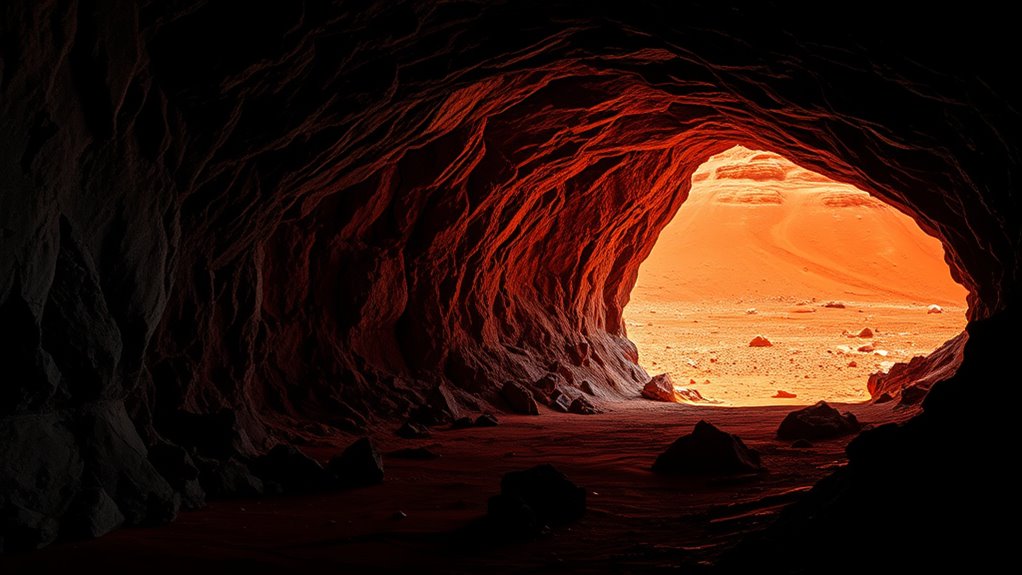Martian lava tubes could be ideal homes for astronauts because they provide natural protection from radiation, temperature extremes, and micrometeorites. These underground tunnels are large, stable, and offer easy access to water ice or brines, making them valuable resource reservoirs. Their expansive interiors could host habitats and exploration corridors, reducing surface hazards. If you want to discover how these formations might guarantee safer, more sustainable living on Mars, there’s more to explore below.
Key Takeaways
- Martian lava tubes offer natural protection from radiation, temperature extremes, and micrometeorites, making them ideal habitats for astronauts.
- Their stable interior environments could house water ice or brines, providing essential resources for sustained missions.
- Low gravity allows for larger, extended underground corridors, facilitating scalable habitats and exploration facilities.
- Skylights and surface features enable potential access points for entry and exploration of subsurface habitats.
- Utilizing lava tubes can reduce construction costs and risks compared to surface-based habitats on Mars.

Have you ever wondered how underground caves form on Mars? These natural structures, known as lava tubes, originate from fast-moving basaltic lava flows that are common in the planet’s volcanic regions. When lava flows from shield volcanoes like Olympus Mons or Arsia Mons, the outer surface cools rapidly, solidifying into a hardened crust. Meanwhile, the still-molten interior continues to flow beneath, creating a flowing conduit. Once the lava supply stops, the remaining molten rock drains away, leaving behind a hollow tunnel beneath the surface. Because Mars has only about 38% of Earth’s gravity, these tubes can grow much larger in diameter and length than similar structures on Earth. This lower gravity allows the lava to spread wider and flow farther, forming expansive underground corridors. Fluid pahoehoe-type lava, characterized by its low viscosity, is particularly prone to creating these large, stable tunnels, making them promising candidates for future exploration and habitation.
Orbital imagery reveals many of these lava tubes across Mars’s volcanic landscapes. Large volcanic regions like Olympus Mons, Alba Patera, and the slopes of Arsia Mons display visible signs of these underground features. One of the primary methods for identifying lava tubes from orbit involves spotting “skylights,” which are collapsed sections of the tube roofs. These openings act as natural windows, exposing the interior of the tubes and serving as potential entry points for explorers. The terrain and elevation influence where tubes form, their shape, and how accessible they are. Many of these tubes remain uncharted, with only the most prominent features mapped and studied so far, leaving much of their extent unknown.
Martian lava tubes are predicted to be much larger than their terrestrial counterparts, thanks to the planet’s low gravity and broad lava flows. Inside, the walls are often made of glasslike material resulting from rapid cooling, with jagged edges that hint at their violent formation. The interior geometries could be complex, with multiple levels and branching passages, though direct observations are limited to orbital imagery and surface features. These tubes could provide stable environments, shielding inhabitants from extreme surface conditions, such as temperature swings, high radiation levels, and micrometeorite impacts. The interiors might also contain water ice or brines, as suggested by orbital radar data, offering additional resources for future explorers. Furthermore, the stable environment inside lava tubes makes them ideal locations for scientific experiments and potential habitats.
Exploring these structures presents challenges. Accessing them requires sophisticated robotics or human missions capable of traversing unstable ceilings and narrow passages. Skylights may serve as entry points but pose risks for equipment and personnel. Mapping inside the tubes demands new technologies because traditional methods like GPS are ineffective underground. Dust and debris from collapses could block passages or create hazards. Despite these challenges, lava tubes hold incredible promise as protected, stable habitats for future human exploration, offering a natural shield against the harsh Martian environment and the potential for sustainable living on the Red Planet.
Frequently Asked Questions
How Do Lava Tubes Form on Mars?
You might wonder how lava tubes form on Mars. When basaltic lava flows rapidly from volcanoes, its outer surface cools quickly, creating a hardened crust. Meanwhile, the lava underneath keeps flowing, forming a channel. Once the lava drains out, it leaves behind a hollow tube. Due to Mars’ low gravity, these tubes can grow larger and longer than Earth’s, making them fascinating geological features.
Can Lava Tubes Be Used for Agriculture?
You can use lava tubes for agriculture because they offer natural protection from radiation and temperature swings. Their large size and skylights let in natural light, reducing artificial energy needs. Inside, you can create controlled environments with remediated soil and recycling systems for water and nutrients. Although challenges like excavation and soil remediation exist, lava tubes provide a stable, safe space to grow crops and sustain future Mars settlements.
What Are the Risks of Exploring Martian Lava Tubes?
When exploring Martian lava tubes, you face structural risks from brittle, fractured walls prone to collapse. Radiation exposure remains a serious hazard, even inside the caves, especially during solar flares. Accessibility is tough due to uneven terrain, complicating navigation and emergency evacuations. Additionally, you must consider environmental concerns, as damaging these fragile formations could destroy valuable scientific data. Proper planning, specialized equipment, and strict protocols are essential to manage these significant dangers.
How Do Lava Tubes Compare to Other Potential Habitats?
Think of lava tubes as hidden vaults beneath the surface, offering vast, natural shelter compared to surface habitats. You get larger spaces, better protection from radiation, and more stable temperatures. Unlike surface structures, they shield you from storms and micrometeorites and could contain essential resources like water ice. While access and engineering challenges exist, their natural advantages make them a promising, enduring home—like a secret sanctuary carved by nature itself.
What Equipment Is Needed to Enter Martian Lava Tubes?
To enter Martian lava tubes, you’ll need specialized entry and mobility equipment. This includes rugged rovers like the German Aerospace Centre’s SCOUT for traversing rocky terrain, climbing gear for descent, and lightweight suits that resist dust and regulate temperature. Reliable lighting and sensing tools like LIDAR help you see in darkness and map the environment. Communication devices guarantee contact with surface teams, making your exploration safe and efficient.
Conclusion
Imagine stepping into a hidden world beneath Mars’s rugged surface, where lava tubes stretch like ancient, silent caverns whispering stories of the planet’s fiery past. These tunnels could be your sanctuary, shielding you from harsh radiation and temperature swings, offering a safe haven amidst the desolate red landscape. As you settle into this underground refuge, you realize you’re not just surviving—you’re becoming part of a new chapter in human exploration, rooted deep within Mars’s timeless embrace.









